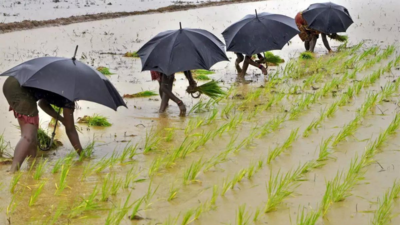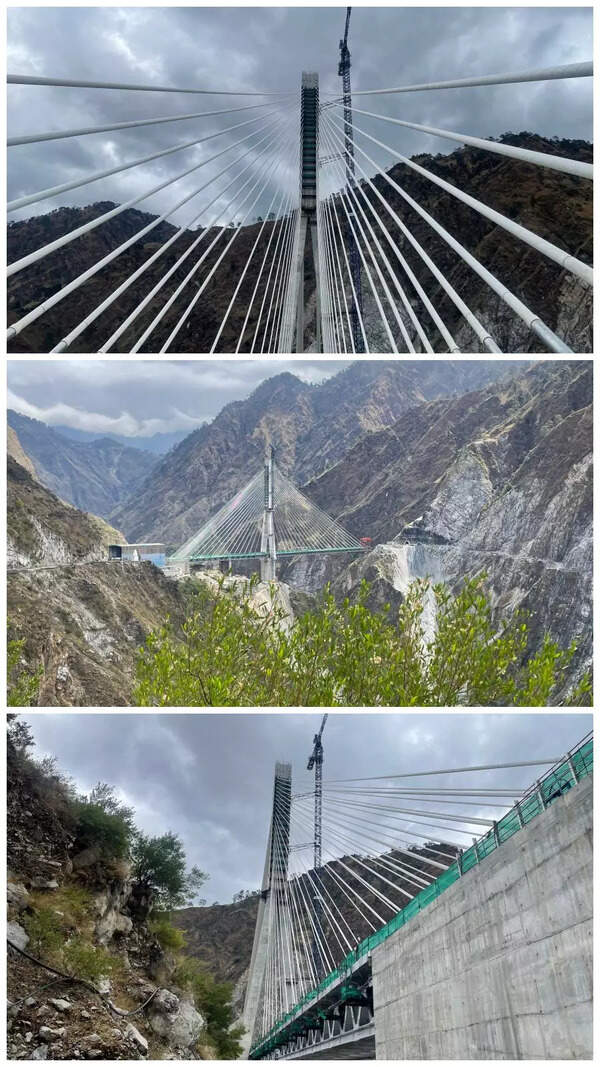- News
- India News
- Normal monsoon rainfall could spur economic growth, help bring down food price inflation
Trending Topics
Normal monsoon rainfall could spur economic growth, help bring down food price inflation

NEW DELHI: India will likely receive normal rainfall during the southwest monsoon season this year, a forecast that comes as a relief for the agricultural sector which heavily relies on monsoon rains for crop production. Normal rain is expected to spur economic growth and could help bring down food price inflation.
"India will see normal rainfall during the southwest monsoon season (from June to September). Around 83.5cm of rainfall is expected ... which is around 96% (with an error margin of 5%) of the long-period average of roughly 87 cm," said M Ravichandran (Secretary) Ministry of Earth Sciences.
The India Meteorological Department (IMD) defines average, or normal, rainfall as ranging between 96% and 104% of a 50-year average of 87 cm for the four-month season.
"There is 67% probability of normal to above-normal rainfall," said M Mohapatra, director general of meteorology, IMD.
The IMD prediction is at odds with the outlook from Skymet. The private weather forecaster on Monday had predicted a below-average monsoon, saying the coming season is likely to bring only 94% of the rain the country usually gets from June to September.
Many factors
According to the IMD, normal to below-normal rainfall is predicted over parts of northwest India, west-central and northeast regions; and normal rainfall is likely over many parts of the peninsular region, adjoining the east-central, east, northeast areas and some parts of northwest India.
Starting 2019, India has witnessed four consecutive years of normal and above-normal rains during the monsoon season. As per IMD data, India will see average or above average rainfall for five straight years for the first time in over two decades.
Mohapatra further said that snow-covered area over the northern hemisphere and Eurasia was below normal from December 2022 to March 2023. A lower snow cover over the northern hemisphere is considered favourable for the subsequent southwest monsoon rainfall over India.
El Nino impact and IOD
"If at all there is any adverse impact due to the evolving El Nino conditions during the monsoon season, it is likely to be countered by the favourable impact of a positive Indian Ocean Dipole (IOD) and the lower snow cover over the northern hemisphere," Mohapatra said.
The Met department head said El Nino conditions are likely to develop during the monsoon season and its impact may be felt in the second half.
He, however, added that not all El Nino years are bad monsoon years and that 40% of the El Nino years in the past (1951-2022) received normal to above-normal monsoon rainfall.
Senior meteorologists said positive IOD conditions are likely to develop during the southwest monsoon season.
El Nino, which is the warming of the waters of the Pacific Ocean near South America, is associated with weakening of monsoon winds and less rainfall in India.
The IOD is defined by the difference in the sea surface temperatures between the western parts of the Indian Ocean near Africa and the eastern parts of the ocean near Indonesia. A positive IOD is considered good for the Indian monsoon.
India's lifeline
Rainfed agriculture is a critical component of India's agricultural landscape, with 52% of the net cultivated area relying on this method. This practice accounts for about 40% of the country's total food production, making it a crucial contributor to India's food security and economic stability.
Unseasonal rains and hailstorms in March damaged rabi crops in large parts of the country, causing losses to thousands of farmers.
The government, however, said wheat production was not impacted due to the unseasonal rains.
An early onslaught of heatwaves had impacted wheat production in India last year, prompting the Centre to ban wheat exports in May. In March this year, the government said the export ban on wheat will continue as long as the country does not feel comfortable with the domestic supplies to meet its food security needs.
(With inputs from agencies)
"India will see normal rainfall during the southwest monsoon season (from June to September). Around 83.5cm of rainfall is expected ... which is around 96% (with an error margin of 5%) of the long-period average of roughly 87 cm," said M Ravichandran (Secretary) Ministry of Earth Sciences.
The India Meteorological Department (IMD) defines average, or normal, rainfall as ranging between 96% and 104% of a 50-year average of 87 cm for the four-month season.
"There is 67% probability of normal to above-normal rainfall," said M Mohapatra, director general of meteorology, IMD.
The IMD prediction is at odds with the outlook from Skymet. The private weather forecaster on Monday had predicted a below-average monsoon, saying the coming season is likely to bring only 94% of the rain the country usually gets from June to September.
Many factors
According to the IMD, normal to below-normal rainfall is predicted over parts of northwest India, west-central and northeast regions; and normal rainfall is likely over many parts of the peninsular region, adjoining the east-central, east, northeast areas and some parts of northwest India.
Starting 2019, India has witnessed four consecutive years of normal and above-normal rains during the monsoon season. As per IMD data, India will see average or above average rainfall for five straight years for the first time in over two decades.
Mohapatra further said that snow-covered area over the northern hemisphere and Eurasia was below normal from December 2022 to March 2023. A lower snow cover over the northern hemisphere is considered favourable for the subsequent southwest monsoon rainfall over India.
El Nino impact and IOD
"If at all there is any adverse impact due to the evolving El Nino conditions during the monsoon season, it is likely to be countered by the favourable impact of a positive Indian Ocean Dipole (IOD) and the lower snow cover over the northern hemisphere," Mohapatra said.
The Met department head said El Nino conditions are likely to develop during the monsoon season and its impact may be felt in the second half.
He, however, added that not all El Nino years are bad monsoon years and that 40% of the El Nino years in the past (1951-2022) received normal to above-normal monsoon rainfall.
Senior meteorologists said positive IOD conditions are likely to develop during the southwest monsoon season.
El Nino, which is the warming of the waters of the Pacific Ocean near South America, is associated with weakening of monsoon winds and less rainfall in India.
The IOD is defined by the difference in the sea surface temperatures between the western parts of the Indian Ocean near Africa and the eastern parts of the ocean near Indonesia. A positive IOD is considered good for the Indian monsoon.
India's lifeline
Rainfed agriculture is a critical component of India's agricultural landscape, with 52% of the net cultivated area relying on this method. This practice accounts for about 40% of the country's total food production, making it a crucial contributor to India's food security and economic stability.
Unseasonal rains and hailstorms in March damaged rabi crops in large parts of the country, causing losses to thousands of farmers.
The government, however, said wheat production was not impacted due to the unseasonal rains.
An early onslaught of heatwaves had impacted wheat production in India last year, prompting the Centre to ban wheat exports in May. In March this year, the government said the export ban on wheat will continue as long as the country does not feel comfortable with the domestic supplies to meet its food security needs.
(With inputs from agencies)
Start a Conversation
FOLLOW US ON SOCIAL MEDIA
FacebookTwitterInstagramKOO APPYOUTUBE










